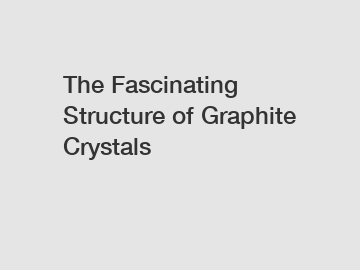The Fascinating Structure of Graphite Crystals
Graphite is a fascinating material that has captured the imagination of scientists and researchers for centuries. Its unique structure, composed of hexagonally arranged layers of carbon atoms, gives rise to a wide range of properties that make it valuable for a variety of applications.
One of the most striking features of graphite is its crystalline structure. While most people are familiar with graphite in the form of a pencil lead, the crystal structure of graphite is actually quite complex and intriguing. In this blog post, we will explore the structure of graphite crystals in more detail and uncover the secrets of this remarkable material.
At the heart of graphite's crystal structure is the carbon atom, which forms the basic building block of the material. In graphite, each carbon atom is bonded to three other carbon atoms in a hexagonal lattice arrangement, giving rise to a two-dimensional sheet of interconnected atoms. These sheets are stacked on top of each other, with weak van der Waals forces holding them together.

The result is a structure that is layered, with each layer consisting of a single sheet of carbon atoms. These layers are known as graphene, and they are incredibly thin, with a thickness of just one atom. This gives graphite its characteristic flaky texture and lubricating properties, as the layers can slide over each other easily.
But what makes graphite truly fascinating is the way in which these layers are arranged. In a perfect graphite crystal, the layers are stacked in an orderly fashion, with each layer oriented at a specific angle to the ones above and below it. This arrangement gives rise to a phenomenon known as cleavage, where the layers can be easily separated by applying force in a specific direction.
The orientation of the layers in a graphite crystal is known as the stacking sequence, and it can have a significant impact on the material's properties. For example, graphite crystals with an ABAB stacking sequence have a higher electrical conductivity than those with an ABCABC stacking sequence, due to differences in the way the layers interact with each other.
In addition to their unique stacking sequence, graphite crystals can also exhibit defects and imperfections in their structure. These defects can occur for a variety of reasons, such as impurities in the material or changes in temperature and pressure during formation. These defects can have a profound impact on the properties of graphite, affecting its strength, conductivity, and other characteristics.
Despite these imperfections, graphite crystals are still incredibly strong and versatile materials. They have a high degree of flexibility and can be easily shaped and molded into a variety of forms. This makes graphite an ideal material for a wide range of applications, from lubricants and pencils to batteries and aerospace components.
In recent years, researchers have begun to explore the potential of graphite crystals in cutting-edge technologies such as graphene-based electronics and materials. Graphene, which is derived from graphite, has incredible strength and conductivity, making it an ideal material for applications such as flexible displays, sensors, and energy storage devices.
Overall, the structure of graphite crystals is a testament to the power of nature to create complex and beautiful materials. From their layered arrangement to their unique stacking sequence, graphite crystals are a marvel of engineering that continues to inspire scientists and researchers around the world. As we continue to unlock the secrets of these remarkable materials, we can only imagine the incredible possibilities that lie ahead.
Are you interested in learning more about Structure of the graphite crystal, Isostatic Press Graphite, Special Graphite Shaped Parts for Sale? Contact us today to secure an expert consultation!

Comments
0